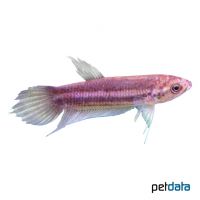Scarlet Betta (Betta coccina)
| Scarlet Betta Betta coccina | |
|---|---|
| Name | Scarlet Betta |
| Name Lat. | Betta coccina |
| Synonym | Wine Red Betta |
| Family | Gouramies |
| Family lat. | Osphronemidae |
| Order | Labyrinth Fishes |
| Order lat. | Anabantiformes |
| Origin | Southeast Asia |
| Habitat | Ponds, floodplains |
| Diet | Carnivore |
| pH | 4.0-6.0 |
| Behavior | ♂ territorial |
| Keeping | Harem |
| Care Level | Experts only |
| Reproduction | Bubble nest builder |
| Breeding | Moderately difficult |
| Life Span | 3-5 years |
| Protection | No |
| Metric Units | |
| Size | 5.5 cm |
| Temperature | 24-27 °C |
| Hardness | 1-5 °dH |
| Aquarium | 60 cm / 54 l |
| US Units | |
| Size | 2.2" |
| Temperature | 75-81 °F |
| Hardness | 18-89 ppm |
| Aquarium | 15 gal |
Distribution and habitat
The distribution area of the red fighting fish is the island of Sumatra (Indonesia). Populations have also been found in the south of the Malay Peninsula (Johor, Malaysia). They live in small, weedy and oxygen-poor ponds, pools and rice fields as well as in floodplains.
Maintenance
The aquarium should have dense planting, with many hiding places (stones, roots). A dark substrate with peat and foliage (sea almond leaves) and subdued light (floating plant cover) is ideal. They only need a shallow water depth, 25 cm is sufficient.
No ammonia, ammonium and nitrite should be detectable, the nitrate value should not exceed 100 mg/l. To ensure the water quality and oxygen content, a filter and heater adapted to the aquarium size is required, as well as lighting for the species-appropriate day-night rhythm of the animals.
Diet
They prefer live food, accordingly the food offer consists of cyclops, daphnia, artemia, mysis, and mosquito larvae, which is accepted without problems also in frozen form, supplemented with commercially available, frozen special food mixtures. High-quality dry food (flakes, granules) is also well accepted.
Regular and varied feeding promotes health and prevents deficiency symptoms. Only feed as much as is eaten immediately (in a maximum of 10 minutes).
Behaviour and compatibility
They should be kept in a harem, one male with several females. Males have a pronounced territorial behavior among themselves and defend their territory consistently. Keeping several harems is only possible in a large, richly structured tank. They can be kept in a community tank with not too small fish and many hiding places, but better in a species tank
Basically, only mutually compatible fish species with similar demands on water quality and water temperature may be socialized.
Sex dimorphism
The male has long extended dorsal and anal fins.
Reproduction and breeding
They belong to the foam nest building fighting fish. The foam nest is built by the male, which also takes care of the brood. The eggs, which are ejected during the numerous matings (entwinements), rise to the water surface, are collected by the male and introduced into the nest. The larvae hatch after about 24 hours and swim freely after 2-6 days.
The fry must be fed several times a day with special rearing food (dust food, Artemia nauplii). In a community tank breeding is hardly possible, because the spawn is easy prey.
Important
They have an additional respiratory organ, the so-called labyrinth (suprabranchial organ) with which they breathe atmospheric air and can suffocate if this is not possible. The air temperature in the breathing area must not be below the water temperature!
Other fish of similar shape and coloration are usually perceived as enemies.
The well-being of the fish should be checked regularly. Temperature should be checked daily, pH, hardness and nitrate value at least every 14 days. Regular partial water changes are recommended, even if the contaminant level has not yet reached the upper limit. Sudden changes in water quality should be avoided. Newly introduced fish must be accustomed slowly to the water in the aquarium.
Further literature can be found in your pet store.
References
Text: petdata; Image: petdata
Source: BMELV (1998): Tierschutzgutachten - Haltung von Zierfischen (Süßwasser); RIEHL & BAENSCH (2004): Aquarien Atlas Bd. 3, Mergus Verlag; ENGELMANN (2005): Zootierhaltung - Tiere in menschlicher Obhut: Fische, Verlag Harri Deutsch
- Gemäß § 21 Abs. 5 Tierschutzgesetz idgF
